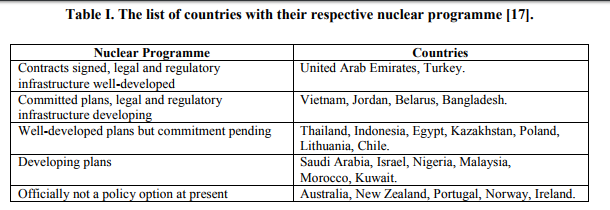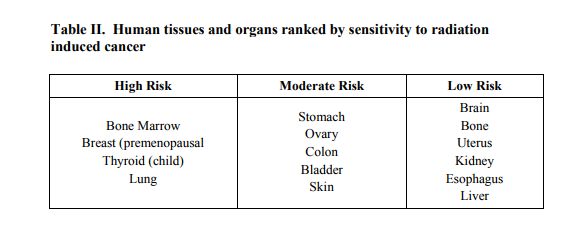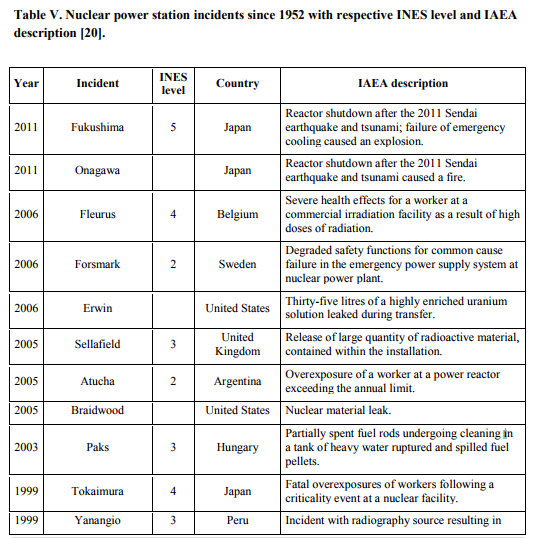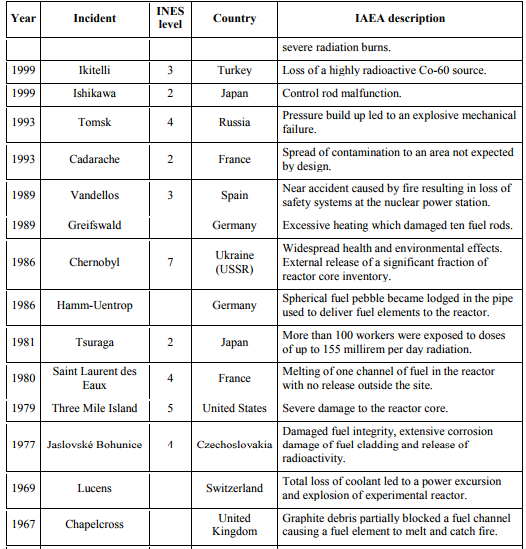IJCRR - 4(3), February, 2012
Pages: 06-14
Print Article
Download XML Download PDF
A STUDY ON NUCLEAR ENERGY: SUSTAINABLE SOLUTION FOR ENSURING ENERGY SECURITY OR
EMERGING FUTURE THREAT
Author: Dewan Mowdudur Rahman, Riasad Amin, Navid Bin Sakhawat, Md. Zubaer Chowdhury
Category: Technology
Abstract:Sustainability is characterized by the environmental friendly process best fitted for eco-systems and the capacity to maintain a process smoothly indefinitely. Maintaining sustainability in every aspect is the key for continuing human race in the long run. Recent energy insecurity problem and global climate change has led the concerned to take a fresh look at the benefits and risks of nuclear power for better future and find out a sustainable solution. Risk from fatal accident and radioactive waste management for a long period of time surely diminish the benefits of nuclear power, such as no green house gas emission and significant amount of power supply with minimum infrastructural development. As nuclear power is all about balancing the benefit and the risk, therefore this paper summarizes the benefit and risk causing from nuclear power to find out a sustainable choice for future energy demand.
Keywords: Nuclear energy, climate change effects, radioactivity, energy demand, sustainable development.
Full Text:
1. INTRODUCTION
Modern age is passing an energy deficient time and the coming days will definitely be starved for energy. About 1.4 billion people (20% of the global population) do not have access to electricity and 2.7 billion people (40% of global population) rely on traditional biomass for basic energy needs such as cooking and heating [1]. Increasing global energy demand combined with the need to minimize Green House Gas (GHG) emission will require the diversification of energy sources, while still ensuring that the bottom 2 billion people- those who live on less than USD 2.5 per day have access to modern energy services. Achieving the goal set in April, 2010 by the UN Advisory Group on Energy and Climate Change (AGECC) for universal access to modern energy by 2030 [2] is a daunting prospect, given the intertwined challenges to tackle natural resources security, energy insecurity and climate change impact. At present, nuclear power appears to be the best choice for many nations. However, integrating nuclear power into a country‘s energy infrastructure is not without challenges. It has a great prospect of supplying sufficient amount of energy with creating less impact to the environment but in the long run there still remains a doubt about its sustainability.
2. Sustainable Development Human beings are said to be at the centre of concerns for sustainable development. We are entitled to a healthy and productive life in harmony with nature. States are seen as having the right, within the principles of international law, to exploit our own resources and the responsibility to ensure that any activities within our jurisdiction do not cause damage to the environment or other States. In addition, the right to development must be fulfilled so as to equitably meet the developmental and environmental needs of present and future generations. Eradication of poverty is seen as a required element of sustainable development. Climate change is a pressing threat to the sustainability of life on earth [3]. It is a highly complex problem that is unpredictable, reflecting an intricate interaction of organizational production processes, government management and regulation, natural forces, and individual behaviour [4]. It is generally held that sustainable development requires attention to the following things:
- Food availability and protection.
- Water availability in adequate quantities.
- Disease prevention and medical treatment.
- Steady and abundant supply of energy specifically, electricity.
- Sewage treatment. Infrastructure development such as schools, factories and transportation.
3. Global Climate Change Effects In recent years, dramatic environmental changes have caused extraordinary climate changes around the globe. This has made countries all over the world to focus on greenhouse effect issue and consider it seriously [5]. It is an important problem that can‘t be ignored because the greenhouse effect causes global warming [6, 7]. In the past century, research and literature has concluded that carbon dioxide (CO2) concentration increased by 28% following the industrial revolution [8]. The global average temperature has increased by 0.3?C to 0.6?C, and the sea level rose 10 to 15 cm in the past 100 years. If greenhouse gas (GHG) emissions continue to increase at the present rate, it is predicted that the average global temperature will increase by about 1?C by the year 2025 and by 3?C at the end of the century [9]. The increase of atmospheric GHG concentration results to a large extent from human activities [10, 11]. Scientists predict if no effective protection policies for the environment are put into place, the global temperature will increase by 1?C to 3.5?C, and the sea level will increase by 15 to 95 cm. This will make many countries uninhabitable by 2100 [12]. The second assessment report of Inter governmental Panel on Climate Change (IPCC) stated that the CO2 concentration in the atmosphere rose from 280 to 358 ppm in 1994 [13]. The World Meteorology Organization (WMO) also pointed out in greenhouse gas annual report in 2007 that the CO2 concentration had already raised to 383 ppm [14]. CO2 is the main GHG emitted from various sources and power sector is solely responsible for 30% emission of CO2 throughout the world [15].
4. Nuclear Energy: An Emerging Source The star, of which our sun is one, relies on nuclear fusion for their output of heat, light and other radiations. If one believes in the Big Bang Theory, then the Earth may be considered as a fragment of the Sun. Fusion reaction is exactly what is happening on the Sun. Energy from fission reaction is derived from a nuclear reaction involving uranium or plutonium as the fuel which originally comes from the fragment of the Sun. Nuclear reactors are either the slow thermal kind using moderators or the fast breeder type using purer fuels and able to generate or ?breed‘ new fuel form which is useful in the context of renewability. It is projected that world primary energy demand will increase by 45 percent between 2006 and 2030, an average annual rate of growth of 1.6 percent slower than the average growth of 1.9 percent per year from 1980 to 2006 [16]. The International Atomic Energy Agency (IAEA), the most authoritative international source of information on nuclear energy, predicted in August 2009 that global nuclear power capacity would be doubled by 2030, from the current 372 gigawats electric (GWe) to 807 GWe. Today, about thirty countries are harnessing nuclear energy in about 440 commercial reactors. Table I. shows the list of countries with their respective nuclear programme.

5. Problems With Nuclear Energy The disadvantages of nuclear energy include: the storage and management of dangerous high level radioactive waste, the possibility of proliferation of nuclear materials and potential terrorist applications, the high cost of building nuclear facilities and the possibility of accidents. Common people awareness is another issue that may also regard as a bar for nuclear energy programme. These disadvantages are listed below with respective description.
5.1 Radioactive Waste High-level radioactive waste is very dangerous. It lasts for tens of thousands of years before decaying to safe levels. It is highly radioactive and is a major barrier for the expansion of nuclear power. More than fifty years of commercial nuclear energy use has left the world with a legacy of tens of thousands of tons of highly radioactive waste that will last for tens of thousands of years [18]. On average, uranium ore contains only 0.1% uranium. Most nuclear reactors require one specific form of uranium, uranium-235 (U-235). This form represents only 0.7% of natural uranium. To increase the concentration of U-235, the uranium extracted from ore goes through an enrichment process, resulting in a small quantity of usable ?enriched‘ uranium and huge volumes of waste. If nuclear power production expands substantially in the coming decades, the amount of waste requiring safe and secure disposal will also significantly increase. High-level nuclear waste can last for thousands of years before being safe again, so this is a major hurdle which must be overcome before nuclear power can expand. Radioactivity can be turned out fatal for human body. Table II. shows major problems caused by radioactivity.

5.2 Proliferation Some forms of nuclear reactor, known as "breeder" reactors produce plutonium, which can, conceivably, be used to make nuclear weapons. This is a conventional explosive mixed with radioactive material with the intention of spreading the material across a wide area to do even more damage. As modern world politics is circling to grab more power and get share of energy of any rival country, therefore any nuclear power generating project could be turned into nuclear weaponry production project at any time.
5.3 Fuel Supply Nuclear fuels are, physically, even rarer than fossil fuels. Fossil fuels at least are made on Earth, albeit over millions of years. Heavy elements like Uranium are only made as stars die, in supernovas. Our solar system actually formed from the remains of another star, at which point heavier elements were made. Essentially, once they're gone, they are well and truly gone. Only in particle accelerators can heavier elements be made. Therefore the type of fuel required for nuclear power programme is not abundant at all.
5.4 Changing Perception of Common People Common people always posses a doubtful mind regarding nuclear energy. They feel free considering its capability to deliver huge power but become fearful when they consider its adverse effects. Table III. and IV. are showing the drastic change of the perception of common people and the reflection of doubtful mind setup about nuclear energy programme.


This changing mind setup of common people create dilemma among decision makers to take any major decision about launching nuclear power programme.
5.5 Accidents Happened So Far Nuclear power generating programme have been caused for some fatal accidents so far. To judge the severity of those accidents International Nuclear Events Scale (INES) has been introduced starting from 0 to 7. Table V. lists these accidents with respective INES scale and International Atomic Energy Agency (IAEA) description.



6. Nuclear Energy: Sustainable Solution or Future Threat Nuclear energy is clean and has a potential to guarantee the world to serve with an everlasting supply of fuel without affecting resources sorely needed for other applications. However, so far little has possibly been known about the damages associated with nuclear power generation. The valuation of damages is further complicated because they are likely to occur only after several decades. Therefore it is difficult to estimate the benefit of nuclear energy avoiding its risk. Nuclear power generation is seemingly profitable. However when real costs are taken into account, nuclear is often more expensive than fossil fuels. For instance, nuclear energy takes a long time to produce. The process of permitting, environmental impact studies and the length of time from planning to design and construction of the nuclear infrastructure typically last no less than several decades. Plus nuclear waste is still considered to be more controversial than fossil fuel emission, often requiring large underground storage facility. Despite these obvious hurdles, perhaps the most important challenge for this industry is about the risk of fatal accident and spreading radiation. Because casualty and fearful damage from such accident is not that so easy to handle by sending emergency rescue team and providing immediate shelter or medicine, the brutal effects of this type of damage pass from one generation to another through radioactivity and can be caused of an everlasting suffering for human race.

7. CONCLUSION
The authors of this paper evaluated one of the key debatable issues influencing the achievement of energy security both at present and in the foreseeable future. The facts have raised from neutral point of view considering their future impacts. The present trend of switching source of energy from classic fossil fuel to nuclear energy for countries is seemingly attractive for the long run of sustainability due to its reduction in global warming, climate change, and improvement in energy security. But energy security is such a issue that must be addressed considering an energy policy include: security of supply, environmental impact, national competitiveness and social concerns. Nuclear energy definitely has its potential to meet worldwide increasing energy demand but when security and safety issue comes into account then it becomes a tough situation to take it as a potential alternative of energy. Therefore it can not be said that nuclear energy is the only alternative and utmost solution for future. Continuous research and development programmes should carried out on this regard to make it best fitted for future and alternative options should put under microscope to find their feasibility for meeting the energy demand in a sustainable way.
ACKNOWLEDGEMENT
Authors acknowledge the immense help received from the scholars whose articles are cited and included in references of this manuscript. The authors are also grateful to authors / editors / publishers of all those articles, journals and books from where the literature for this article has been reviewed and discussed.
References:
1. International Energy Agency, World Energy Outlook 2010. Available: http://www.worldenergyoutlook.org
2. The UN Secretary General‘s Advisory Group on Energy and Climate Change (AGECC), Summary report and recommendations 2010, New York. Available: www.unido.org/fleadmin/ user_media/Publications/download/AG ECCsummaryreport.pdf
3. R. Watson, M.C. Boudreau and A.J. Chen, ?Information Systems and Environmentally Sustainable Development: Energy Informatics and New Directions for the IS Community,? Management Information Systems Quarterly, Vol. 34, No. 1, 2010, pp. 23-38.
4. H. Hasan and C. Dwyer, ?Was the Copenhagen Summit Doomed from the Start? Some Insights from Green IS research,? Americas Conference on Information Systems 2010 Proceeding, Lima, 2010, p. 67.
5. H.J.D. Boeck, C.M.H. M. Lemmens, B. Gielen, H. Bossuyt, S. Malchair, M. Carnol, R. Merckx, R. Ceulemans and I. Nijs, ?Combined Effects of Climate Warming and Plant Diversity Loss on above and below Ground Grassland Productivity,? Environmental and Experimental Botany, Vol. 60, No. 1, 2007, pp. 95-104. doi:10.1016/j.envexpbot.2006.07.001
6. V.A. Frolkis, I.L. Karol and A.A. Kiselev, ?Global Warming Potential, Global Warming Commitment and Other Indexes as Characteristics of the Effects of Greenhouse Gases on Earth‘s Climate,? Ecological Indicators. Vol. 2, No. 1-2, 2002, pp. 109-121. doi:10.1016/S1470- 160X(02)00047-X
7. A. Smith, ?Global Warming Damage and the Benefits of Mitigation,? Fuel and Energy Abstracts. Vol. 37, No. 3, 1996, p. 221. doi:10.1016/0140- 6701(96)89126-0
8. Beier, B.A. Emmett, J. Peñuelas, I.K. Schmidt, A. Tietema, M. Estiarte, P. Gundersen, L. Llorens, T. RiisNielsen, A. Sowerby and A. Gorissen, ?Carbon and Nitrogen Cycles in European Ecosystems Respond Differently to Global Warming,? Science of the Total Environment, Vol. 407, No. 1, 2008, pp. 692-697. doi:10.1016/j.scitotenv.2008.10.001
9. Intergovernmental Panel on Climate Change (IPCC), ?Climate Change 2007: Synthesis Report Summary for Policymakers,? The 8th Session of Working Group II of the IPCC, Brussels, April 2007, pp. 2-3.
10. T. Beer, T. Grant, D. Williams and H. Watson, ?Fuel cycle Greenhouse Gas Emissions from alternative Fuels in Australian Heavy Vehicles,? Atmospheric Environment, Vol. 36, No. 4, 2002, pp. 753-763. doi:10.1016/S1352-2310(01)00514-3
11. H. Hayami and M. Nakamura, ?Greenhouse Gas Emissions in Canada and Japan: Sector-Specific Estimates and Managerial and Economic Implications,? Journal of Environmental Management. Vol. 85, No. 2, 2007, pp. 371-392. doi:10.1016/j.jenvman.2006.10.002
12. F. Georgios and C. Paul, ?Global Warming and Carbon Dioxide through Sciences,? Environment International, Vol. 35, No. 2, 2009, pp. 390-401. doi:10.1016/j.envint.2008.07.007
13. Intergovernmental Panel on Climate Change (IPCC), ?Second Assessment Synthesis of Scientific Technical Information relevant to interpreting Article 2 of the UN Framework Convention on Climate Change,? Intergovernmental Panel on Climate Chang, Geneva,1995.
14. World Meteorological Organization (WMO), ?WMO Greenhouse Gas Bulletin 2007: Atmospheric Carbon Dioxide Levels Reach New Highs,? Geneva, 2007.
15. T. Jilani, K. Gomi and Y. Matsuoka, ?Integration of sustainable and low carbon society towards 2025 in Bangladesh,? in International Conference on Climate Change Effects and Energy Development in Bangladesh, Germany, July, 2011
16. International Energy Agency (2008), World Energy Outlook 2008. Available: http://www.worldenergyoutlook.org
17. World Nuclear Association (online). Available: http://www.worldnuclear.org, accessed on 27th November, 2011.
18. C.D. Ferguson, ?Nuclear Energy Balancing Benefits and Risks,? council on foreign relations, CSR No. 28, April, 2007
19. WIN/Gallop poll, ?Japan Earthquake Jolts Global Views On Nuclear Energy,? April 19, 2011, Available: www.nrc.co.jp
20. Nuclear power station incidents since 1952 with respective INES level and IAEA description (online). Available: http://www.guardian.co.uk, accessed on 3rd December, 2011.
|






 This work is licensed under a Creative Commons Attribution-NonCommercial 4.0 International License
This work is licensed under a Creative Commons Attribution-NonCommercial 4.0 International License